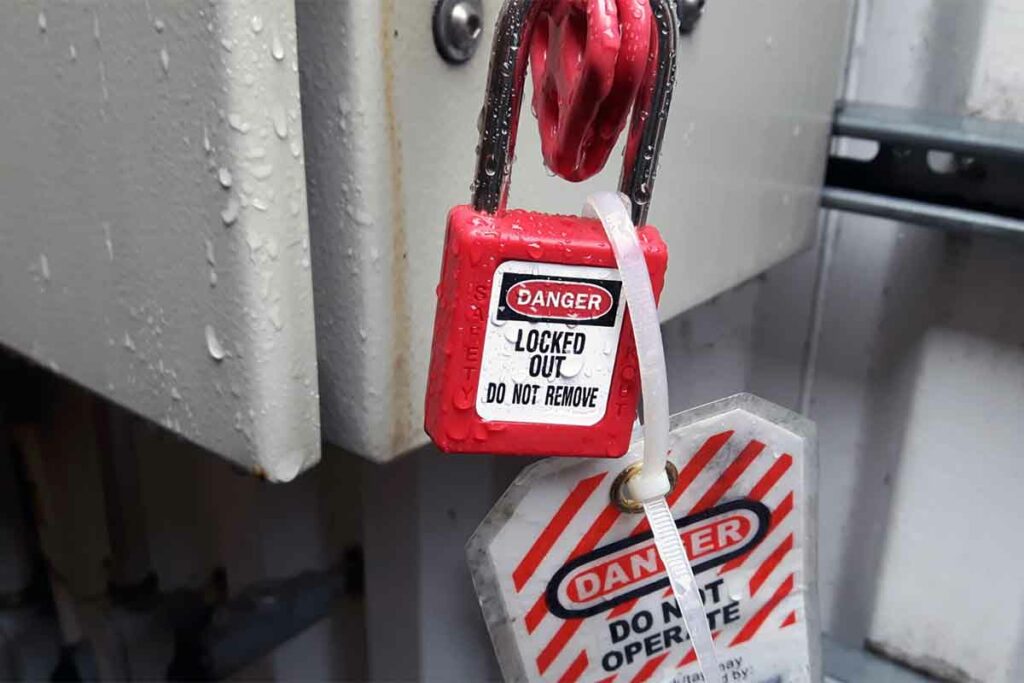Lockout/Tagout (LOTO) Training
The Lockout/Tagout (LOTO) course focuses on the proper procedures for isolating energy sources during maintenance or repair work. Participants will learn about energy control measures, lockout/tagout devices, and risk assessment to prevent accidental energy release and protect workers.
Lockout/Tagout safety training is designed to teach workers how to properly de-energize and lockout equipment to prevent unexpected startup or release of stored energy, which can cause serious injuries or even fatalities.
Is There a Difference Between Lockout & Tagout?
Although “lockout” and “tagout” are usually used within the same context, there is a difference between the two terms. “Lockout” refers to when an energy source is physically isolated from the machinery that uses it. An example of lockout would be turning off and locking a circuit breaker to ensure there is no power source to a particular piece of equipment. “Tagout” refers to the process of ensuring a tag or label communicating the status of a given piece of equipment or machinery is affixed to it.Why Lockout/Tagout Training is Important
Protects Workers: Lockout/Tagout safety training can help prevent injuries by teaching workers how to properly lock and tag out equipment during servicing or maintenance activities. Ensures Compliance: Many regulatory bodies require companies to provide lockout/tagout training to their employees. Failure to comply with these regulations can result in fines and penalties. Reduces Downtime: Proper lockout/tagout procedures can also reduce equipment downtime by preventing breakdowns caused by improper servicing. Improves Workplace Safety Culture: Investing in lockout/tagout safety training demonstrates a commitment to workplace safety and can help create a safety culture within an organization.Lockout/Tagout Courses
Investing in Lockout/Tagout safety training is critical for any workplace where machinery or equipment is serviced or maintained. By providing employees with the necessary training and knowledge, you can create a safer and more efficient workplace for everyone. Contact us today to learn more about our Lockout/Tagout safety training courses.Course Topics
- Duties of those in the workplace
- Legal requirements and penalties
- Hazards
- Lockout tagout devices
- Seven steps of lockout tagout
- Common mistakes
- Creating a workplace program
This online Electrical Safety for Construction: Power Lines and Lockout/Tagout course covers the following topics:
- Electrical Hazards
- Hazard Precautions
- Equipment around Power Lines
- Lockout/Tagout
- Employer Requirements
- Identify major electrical hazards
- Protect yourself from electrical hazards
- Recognize employer requirements to protect workers from electrical hazards
- Hydraulic fluids
- Exposure to hydraulic fluids
- Potential hazards
- Personal protective equipment (PPE)
- Safety standards and qualifications
- Your role in your facility
- Types of hydraulic hoses and construction
- Hydraulic hose applications
- Hydraulic hose assembly fabrications
- Specifications and standards
- Life cycle
- How accumulators work and their applications
- Forms of hazardous energy
- Commonly used thread connections in hydraulic systems
- Pressure ratings
- Types of seals and applications
- Maintenance and planning
- Importance of seals guarding
- System considerations
- Devices
- Pressurized grease
- Gravity
- Overhanging and runaway hazards
- Effects of modifications to hydraulic components
- Hazards of welding hydraulic components
- Purpose of hazard assessment
- General responsibilities
- Before work begins
- Inspections
- Lockout
- Zero energy state
- Hydraulic fluids and the environment
- Spill preparedness
- Acceptable disposal practices





